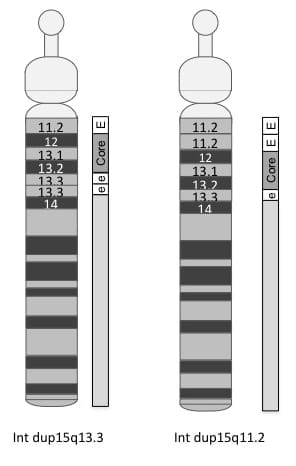Types of 15q Duplications
There are several genetic variants of chromosome 15q duplications.
Chromosome 15q11.2-13.1 Duplication Syndrome (Dup15q Syndrome)
Chromosome 15q11.2-13.1 duplication syndrome (Dup15q syndrome) is a clinically identifiable syndrome which results from the duplication (or multiplication) of a portion of chromosome 15.
Each chromosome has unique regions or bands that contain genes, and each band is labeled numerically. The extra genetic material known as Dup15q syndrome contains the bands on chromosome 15 at the q arm labeled 11.2-13.1. It can span past these bands but must contain the 11.2 – 13.1 region to be identified as Dup15q syndrome. Chromosome 15q duplications are associated with autism spectrum disorders, developmental delay, learning disabilities/cognitive delays, and seizures/epilepsy.
Clinicians should suspect this syndrome in any infant/child with the following clinical features:
-
Moderate-to-severe hypotonia in infancy and early delays in reaching motor milestones
-
Developmental delay that includes not only motor but also language
- Intellectual disability (ID)
-
Autism spectrum disorder (ASD)
-
Seizures, particularly infantile spasms
-
Behavioral difficulties including hyperactivity, anxiety, or emotional lability [Al Ageeli et al 2014]
-
A characteristic EEG biomarker involving excessive beta oscillations (12–30 Hz) [Frohlich et al 2016, Saravanapandian et al 2020]
- Features including upturned nose, epicanthal folds when the skin fold of the upper eyelid covers the inner corner of the eye, and downslanting palpebral fissures when the opening between the two eyelids slants downwards.
Chromosome 15q duplications most commonly occur in one of two forms, either as an extra isodicentric 15 chromosome or as an interstitial duplication of chromosome 15q.
Isodicentric 15
Isodicentric chromosome 15, abbreviated idic(15), is diagnosed in individuals who have 47 chromosomes (or sometimes more) instead of the typical 46 chromosomes. The extra chromosome is made up of a portion of chromosome 15 that has been duplicated and “inverted,” so that there are two copies of part of chromosome 15q attached to one another that appear to be mirror images. Because of this arrangement, idic(15) used to be referred to as “inverted duplication chromosome 15.” Most commonly, the region called 15q11-q13 is the portion of chromosome 15 duplicated. Sometimes the duplicated region is larger. The size of the idic(15) varies depending on the size of the region of chromosome 15 that is duplicated.
Inheritance:
The maternal idic(15) Dup15q variant is reported as de novo in all affected individuals reported to date; thus, risk to siblings is low. Individuals with idic(15) Dup15q variant are not known to reproduce.
MOSAICISM
Some children and adults with idic(15) are said to have “mosaicism”, meaning that their idic(15) is not present in all of the cells in their bodies. Mosaicism happens by chance in this and many other chromosomal disorders.
Interstitial Duplication 15
Interstitial Dup15q is diagnosed in people born with the typical 46 chromosomes, but who has a segment of duplicated material within chromosome 15, are said to have an interstitial duplication chromosome 15. Most often this is the same section (15q11-q13) that makes up the extra chromosome in idic(15). For this reason, people with interstitial duplications of 15q and those with idic(15) share similar characteristics.
When the extra genetic material comes from the paternal chromosome, a child may have normal development. However, when the duplicated material comes from the maternal chromosome, developmental problems are often the result. In most cases of chromosome 15q11.2-13.1 duplication syndrome, the chromosome duplication is not inherited but occurred as a random event during the formation of reproductive cells (eggs and sperm).
Inheritance:
Isodicentric 15 (IDIC15)

Mosaicism

Interstitial Duplication 15

15Q13.3 Microduplication Syndrome
15q13.3 microduplication syndrome was first described in 2009. It includes small duplications located on chromosome 15q in the region 13.2 -13.3. See the area on the diagram labeled “e”. Although this chromosomal abnormality occurs very close to the PWS/AS region (15q11.2-13.1) that is affected in Dup15q syndrome and labeled as “Core” on the diagram, the symptoms can vary significantly from Dup15q syndrome. There is a wide range of symptoms in individuals with this microduplication, even among members of the same family who have the same genetic diagnosis. More research is needed in this area.
View the National Institute of Health webpage
15Q11.2 Microduplications
We are aware of several families who have received a diagnosis of a small duplication of chromosome 15q in the area 11.1-11.2. This area is labeled as “E” on the diagram. Currently, there is not much information available on this abnormality, but it appears that the symptoms are also different from Dup15q syndrome, despite the proximity of the duplications. More research is needed in this area.


